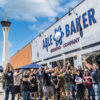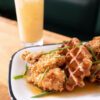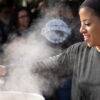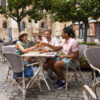5 German-style Märzen Homebrew Recipes
The name Märzen refers to the tradition of brewing this German-style lager beer in March and lagering it in cold caves during the summer. Sometimes, Marzens take on the familiar name Oktoberfest.
The following overall description of Märzen is from the 2021 Beer Judge Certification Program (BJCP) Style Guidelines:
An amber, malty German lager with a clean, rich, toasty, bready malt flavor, restrained bitterness, and a well-attenuated finish. The overall malt impression is soft, elegant, and complex, with a rich malty aftertaste that is
never cloying or heavy.
For more beer recipes, visit our Homebrew Recipes Library.… Read the rest “5 German-style Märzen Homebrew Recipes”
Vegas (Beer), Baby!
Luck—or lack thereof—can make or break a visit to Las Vegas, but fortunately that rule need only apply to gamblers. The thousands of brewing industry professionals headed there for the 2024 Craft Brewers Conference April 21-24 won’t need good fortune to navigate their way to high-quality local beer. We’ve combed the desert and laid out a stellar septet of Las Vegas breweries to visit when the seminars let out. They all make for reliable starting points, but feel free to venture beyond this “lucky seven” as the craft beer scene in Sin City (and in neighboring Henderson) is on the rise thanks to a rising-tide mentality.… Read the rest “Vegas (Beer), Baby!”
Order Your Copy of Modern Lager Beer & Save
Members, check your email for an exclusive discount code for 25% off—no code needed for free shipping!
Boulder, Colo. — Just Released! Modern Lager Beer: Techniques, Processes, and Recipes, the latest title from Brewers Publications®, gives brewing professionals and beer enthusiasts a reason to rejoice as Jack Hendler and Joe Connolly, two renowned figures in the brewing industry, unveil their latest masterpiece. This comprehensive guide promises to revolutionize how brewers approach and appreciate the art of lager brewing.
In Modern Lager Beer, Hendler and Connolly draw upon their extensive experience and research to offer readers an in-depth exploration of contemporary lager brewing techniques, processes, and recipes.… Read the rest “Order Your Copy of Modern Lager Beer & Save”
Bird + Brew: A Culinary Coupling
The worlds of beer and chicken have been aligned for ages, but it wasn’t until 2021 that chimaek, a Korean portmanteau for fried chicken and light beers, was welcomed into the Oxford English Dictionary. This culinary coupling of bird and brew is broader than wings and lagers, though—roasted, grilled, and chile-coated chicken finds local Pilsners, pales, and IPAs to fill that bucket.
At Shy Bird in Boston, an all-day rotisserie, bar, and cafe, all-natural, pasture-raised birds are transformed into full-flavored spinning showpieces that can be matched with one of six beers on tap, or a dozen by the can.… Read the rest “Bird + Brew: A Culinary Coupling”
23 Medal-Winning Stout Recipes from National Homebrew Competition
Stouts make up some of the most-entered styles each year in the National Homebrew Competition. From dry or sweet to imperial and historical, homebrewers from around the world put their best stout forward in the world’s largest amateur brewing competition.
Imperial & Wood-aged Stout Recipes
They’re big, they’re bold, and they’re a favorite among beer drinkers. Wood-aging an imperial stout is a great way to add a new layer of complexity.
- Mandy & Wesley’s Imperial Stout
- Han Solo Shot First Imperial Stout
- Bourbon Barrel-aged Full Eclipse II
- Richard’s Brownie Batter Imperial Stout
- Mill Em All Imperial Stout
American & Irish-style Stout Recipes
American- and Irish-style stouts tend to both be dry, but live on different ends of the hoppiness spectrum.… Read the rest “23 Medal-Winning Stout Recipes from National Homebrew Competition”
France Is Not a Beer Country, but It Could Be
France is not a beer country—that’s a fact. France attracts approximately 75 million international travelers every year. They come for the wine and delicious bread and viennoiseries, not for beers as they would be when visiting neighboring countries such as Belgium or Germany. Part of France’s beer history is missing, so much so that historians have difficulty collecting an accurate picture of beer consumption there through the centuries.
“Beer, prehistoric and ancient, remains poorly known despite its wide consumption. As the Gauls did not leave any writings, we have no direct testimony from them about their national drink,” writes archeologist Fanette Laubenheimer in her book Boire en Gaule.… Read the rest “France Is Not a Beer Country, but It Could Be”
Registration Opens for the Highly Anticipated National Homebrew Competition
By the Brewers Association
Boulder, Colo. — The National Homebrew Competition, the premier event celebrating the art and craft of brewing, is thrilled to announce the opening of registration for its upcoming competition. Homebrewers, mead- and cidermakers worldwide are invited to showcase their fermentation prowess and vie for top honors in this esteemed event.
This annual competition, organized by the American Homebrewers Association® (AHA)—the national not-for-profit organization dedicated to advancing the hobby of homebrewing—brings together passionate homebrewers of all skill levels to compete for gold, silver, and bronze medals in various beer, mead, and cider categories.… Read the rest “Registration Opens for the Highly Anticipated National Homebrew Competition”
How To Find, Print, or Request AHA Member Card
American Homebrewers Association (AHA) membership assistant Kara is here to show you everything you need to know about accessing your AHA membership card and number.
This video covers:
- How to access your member card from your HomebrewersAssociation.org account
- How to download and/or print your card
- How to request a free physical membership card
For additional assistance with your membership experience, visit the Frequently Asked Questions or reach out to your Membership Team.
The post How To Find, Print, or Request AHA Member Card appeared first on American Homebrewers Association.… Read the rest “How To Find, Print, or Request AHA Member Card”






